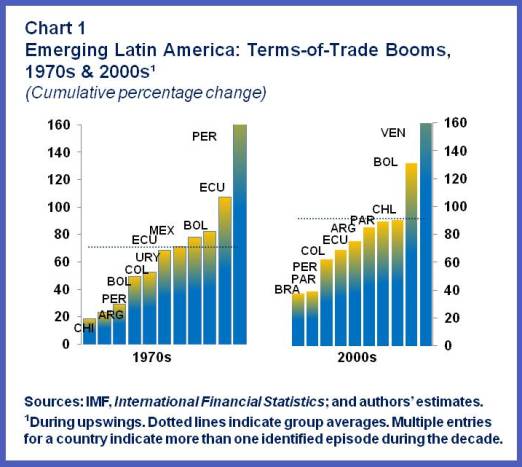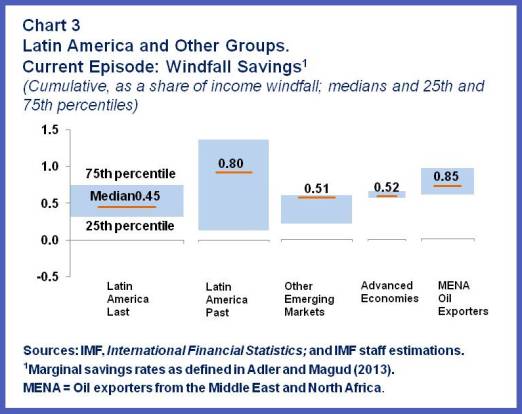Commodity exporting countries in Latin America have benefited strongly from the commodity price boom that began around 2002. And the accompanying improvements in public and external balance sheets have fed a sense that this time the macroeconomic response to the terms-of-trade boom has been different (and more prudent) than in past episodes. But, has it?
In our recent work, we analyze the history of Latin America’s terms-of-trade booms during 1970–2012 and quantify the associated income windfall (i.e., the extra income arising from improved terms-of-trade). We also document saving patterns during these episodes and assess the extent of the “effort” to save the income windfall.
Our findings suggest that, although the additional income shock associated to the recent terms-of-trade boom is unprecedented in magnitude, the effort to save it has been lower than in past episodes.
The recent terms-of-trade boom in historical perspective
A historical comparison of episodes of large terms-of-trade shocks—found only in the 1970s and the 2000s—shows that, while sizable, Latin America’s recent boom has not been much larger than those seen in the 1970s (see Figure 1). However, it has been quite larger than in other regions, and only comparable to those experienced by the oil-exporting countries in the Middle East and North Africa region (see Working Paper for regional comparisons).
At the same time, the associated income windfall has been much larger in the recent episode than in the past (see Figure 2), due to a higher degree of trade openness and a longer duration of the boom. Furthermore, the effect of the recent boom has been quite sizable in absolute sense, with an increase in income close to 15 percent per year. In other words, income has been 15 percent higher than what it would have been had no terms-of-trade shock occurred.
Within the region, Bolivia, Chile, and Venezuela, stand out as having benefited the most, with increases of 30 percent per year for Venezuela and 20 percent for the other two. Again, these measures are only comparable to those seen in some Middle East countries. Brazil stands at the other extreme of the distribution, with significantly lower windfall estimates, while terms-of-trade changes in Mexico and Uruguay during the last decade do not qualify, under our definition, as booms.
Saving more of the income windfall this time?
A comparison of aggregate saving rates suggests that, compared to the past, the region’s response to the recent boom has been more prudent. The median saving rate increased by about 4-5 percentage points of GDP, as opposed to 2-3 percentage points in past episodes. This has been accompanied by a remarkable increase in investment (about 5 percentage points), in clear contrast with the past, but leading to a gradual weakening of current account balances.
Does this mean the region made a greater effort to save the windfall this time? Not necessarily. In fact, estimates of marginal saving rates—a measure of the increase in saving as a proportion of the estimated windfall—suggest that commodity exporters have saved less of the windfall this time (see Figure 3). Latin America’s saving effort is also low compared with countries with a similar income windfall (the oil exporting countries in the Middle East). And efforts to save the windfall have gradually declined following the 2008–09 crisis.
Also, a growing share of the windfall is being devoted to domestic (physical) capital formation rather than to improving countries’ international asset position (via increasing saving abroad), which has affected post-boom real income differently in the past. This has resulted in a gradual weakening of current accounts.
Saving the extra does pay off
What can we learn from saving patterns during past boom episodes, in terms of their implications for post-boom income? A simple econometric exercise points to a high pay off from saving the windfall during the boom, in terms of raising post-boom income. More importantly, the composition of the windfall saving matters as allocating the extra income to foreign asset accumulation appears to deliver higher post-boom income than when invested domestically. Whether this reflects the benefits of having a stronger net foreign assets position or a cost of misallocating domestic resources during the boom remains an open question. What we do see is that this result seems to have been especially true for Latin America in the past.
Overall, these results suggest that the improved balance sheets in the region may reflect mainly the sheer size of the income windfall of the latest terms-of-trade boom, rather than a greater effort to save it. And, with signs of further softening of saving rates and weakening external current account balances, a closer look into saving/investment patterns may be desirable.







